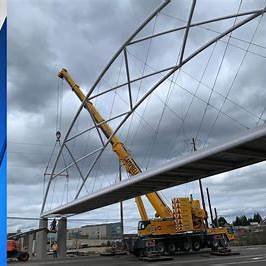Our New Pedistrian Bridge, Why, How, and How Much
Sherwood is moving forward, literally and figuratively, with the construction of a new pedestrian and bicycle bridge over Highway 99W. From my first year in office, as a city councilor, then as council president, I have consistently advocated for this bridge. It represents more than just improved transportation; it's a commitment to public safety, accessibility, and responsible growth. This transformative project will physically connect our city's west and east sides, improving mobility and public safety while opening up new possibilities for recreation, education access, and economic development.
This bridge will:
Provide a safe, ADA-compliant route for pedestrians and cyclists to cross Highway 99W.
Connect Sherwood High School directly to the Sherwood Regional Family YMCA would allow students and families safer access to key community resources.
Integrate East Sherwood with the west side trail system, strengthening regional mobility for residents, joggers, and cyclists.
Provide essential infrastructure to support the new Sherwood West expansion area, handling increased traffic and accessibility needs as the community grows.
Serve as a landmark project showcasing our commitment to innovative, connected development.
The bridge will feature gentle, accessible slopes, lighting, security measures, and durable materials designed for long-term use. It is engineered to span 230 feet and be 14 feet wide and harmonize with the surrounding landscape while crossing three roads. Construction began in 2024 and is expected to conclude in 2025, with minimal disruption to current highway traffic thanks to innovative off-site assembly and crane placement strategies.
How Are We Paying for It?
The total budget for the bridge project is $30 million (27.8 million assuming contingency budget is not used), and we’ve put together a funding strategy that is both practical and fiscally responsible:
$4 million is coming from state lottery funds.
The remaining $23.8 to 26.0 million will be funded through our Urban Renewal Area (URA) via Tax Increment Financing (TIF).
Our URA is projected to generate $84 million over 30 years, making this investment sustainable and aligned with our long-term economic growth. It should be noted that the previous URA paid for our library, the arts center, Cannery Square, and the revitalization of Old Town over 20 years ago. The current URA is also paying for part of our Sherwood Broadband Fiber to Home Project.
So, how does TIF work?
Think of Tax Increment Financing (TIF) as setting aside future tax growth to pay for today's improvements. When an area is designated as an Urban Renewal Agency (URA), property owners within the URA continue paying their regular taxes with no increases in their assessed market value tax rate. That’s important, no new taxes.
Instead, what changes is where the new incremental tax revenue goes as assesed market values increase year over year, As the area grows and assessed market values rise, the additional taxes collected—the "increment" are set aside to reinvest in that area. That money is then used to pay for projects like our bridge.
It’s like using the future value created by a neighborhood’s success to help build what that neighborhood needs to succeed.
Importantly, this increment includes tax revenue that would typically go to all the taxing entities in the area, such as the county and special districts, not just the City of Sherwood. Sherwood is one of approximately 10 taxing agencies on your property tax bill. This allows us to bring outside dollars back into our community to fund infrastructure.
In our case, this means no new taxes are being raised to pay for the bridge. Instead, we’re using the future growth in tax revenue generated by rising property values to invest in the infrastructure our community needs today.
Why Build the Bridge Now?
We consciously decided not to wait until we had cash in hand. Here’s why:
Construction inflation is currently running between 7% and 10% annually. The cost to finance the bridge against future TIF revenue is significantly less.
Waiting would have meant a significantly higher project cost.
By acting now, we lock in a more favorable cost and avoid being priced out of our infrastructure goals.
Innovative Financing: Borrowing From Ourselves
We needed to take out a loan to start, with all repayments coming directly from TIF (Tax Increment Financing) revenues. We had two choices:
Borrow from a bank and pay them interest.
Borrow from our Water Fund and repay it with TIF revenue.
We chose option two because paying ourselves interest is better than enriching a bank. The Water Fund will still be repaid (with interest) to meet future capital needs and scheduled maintenance in our water system. It’s a win-win. It should be noted that we are legally required to pay the loan under state law.
Budget Discipline
The $30 million budget includes a 2.2 million contingency, ensuring we’re prepared for unexpected costs. The best news?
The project is on schedule and budget.
At this time, we do not expect to use contingency funds.
Thanks to prudent planning, we’re building it the smart way. Our staff and contractors are doing an outstanding job, keeping the project on schedule and on budget. We often hear stories of public projects where costs spiral out of control due to budget overruns and unexpected setbacks. That’s not happening here. Through strong project management, coordination, and execution, this bridge project is moving forward exactly as planned. It’s a testament to the professionalism and dedication of everyone involved—from city staff to engineers and builders, who are working hard to deliver real value to our community.




